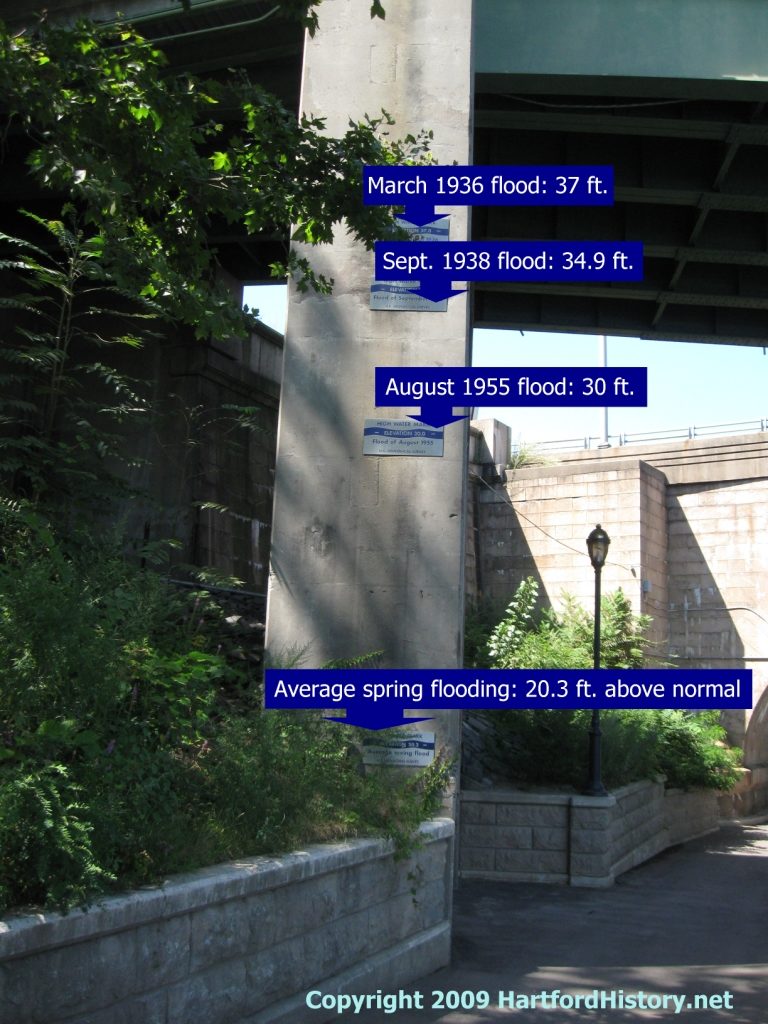The Providence Journal had a nice article recently on Hartford’s historical attractions. Sure, it’s a got a chamber-of-commerce bent, but we’ll take it. Besides, it’s nice to be reminded every once in while of all the attractions we locals take for granted. If you’re coming to the city for the first time and want to know what there is to see, this isn’t a bad place to start. The line about Aetna moving its headquarters to New York City might be premature, however.
Author: Kevin Flood
Stowe Center’s Kane interviewed
The Hartford Business Journal has a nice Q&A with Katherine Kane, who will retire next spring after 20 years as executive director at the Harriet Beecher Stowe Center. The Center has grown and improved vastly on her watch, becoming among other things a great resource for community groups, despite mounting pressures (mostly fiscal) on organizations like hers. She sums up nicely the mission of museums in the 21st-Century:
Museums are not repositories for old ideas and objects, they are vibrant community anchors helping people understand how history informs today and shape a positive future.
David Ransom, Hartford historian
Hartford lost one of its best historians with the recent death of David Ransom, at age 100.
Visitors to HartfordHistory.net may recognize Dave as the co-author, with Gregory Andrews, of “Structures and Styles: Guided Tours of Hartford Architecture,” an indispensable (though, sadly, out-of-print) book that gave thumb-nail sketches of every significant building in the city, including ones even most Hartford denizens took for granted. I had the great pleasure of interviewing him for this article on the book.
Dave also wrote a biography of Hartford architect George Keller and worked closely with just about every preservation group in the region. But in reading his obituary, I’m struck most of all by the fact that Dave turned his focus to architectural history relatively late in life. He had been international sales manager for M. Swift & Sons Inc. of Hartford when, at age 50, he retired and embarked on a new life. The accomplishments after that move speak for themselves:
He was the author of “George Keller, Architect”, the definitive biography of the celebrated Hartford architect. This book is also the acknowledged study of Keller’s vast architectural legacy, which included designs for monuments, houses, institutional buildings and bridges. Dave also wrote “Structures and Styles: Guided Tours of Hartford Architecture”, co-authored with Gregory Andrews. He worked closely with The Connecticut Historical Commission, and was instrumental in establishing historic districts in Hartford, particularly the areas of Congress Street and Lewis Street. In addition, he was a visiting lecturer at Trinity College and served as a board member with several organizations, including Cedar Hill Cemetery, The CT Historical Society, CT Preservation Action, and the West Hartford Historic District Commission. He received the Harlan H. Griswold award, Connecticut’s highest award for historic preservation, from the Connecticut Trust for History Preservation in 1991.
A life well-lived.
Speaking of flooding
The hurricanes and resulting flooding in Texas and Florida reminded me of a photo I took eight years ago in Riverside Park. Near the Bulkeley Bridge, there was a pillar that hosted a series of markers for the high-water points in Hartford’s most severe floods, at least since 1936:
To stand before that pillar and then look across the path at the Connecticut River is to send your imagination reeling:
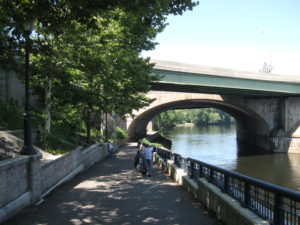
To see the effects of these disasters, check out the photos at the Connecticut Digital Archive. Here, for instance, are search results for the 1936 flood. It’s easy to see why so much was invested in building the dikes that have protected the city since the 1940s:
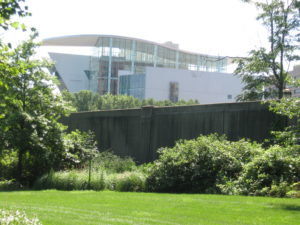
Listen up! There’s a Connecticut history podcast
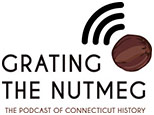 If you need to tune out the everyday world for a little while (and who doesn’t?) listen to “Grating the Nutmeg,” a podcast about Connecticut history. A co-production of the magazine Connecticut Explored and the Office of the State Historian, “Grating” already has an archive of 34 episodes, and some center on Hartford. The most recent of them: Episode 32, entitled “Hops, Beer, and Hartford’s 1902 Brewery Strike.” Guest Steve Thornton of the Shoeleather History Project tells what happened when workers at Hartford’s four (yes, four!) breweries went on strike. There’s also “The NEW Harriet Beecher Stowe Center” (Episode 31), “Art, Agency, Legacy: Amistad Center for Art & Culture” (Episode 29), and “The Smithsonian’s Eric Hintz: Hartford As a Place of Invention (Episode 22), among others.
If you need to tune out the everyday world for a little while (and who doesn’t?) listen to “Grating the Nutmeg,” a podcast about Connecticut history. A co-production of the magazine Connecticut Explored and the Office of the State Historian, “Grating” already has an archive of 34 episodes, and some center on Hartford. The most recent of them: Episode 32, entitled “Hops, Beer, and Hartford’s 1902 Brewery Strike.” Guest Steve Thornton of the Shoeleather History Project tells what happened when workers at Hartford’s four (yes, four!) breweries went on strike. There’s also “The NEW Harriet Beecher Stowe Center” (Episode 31), “Art, Agency, Legacy: Amistad Center for Art & Culture” (Episode 29), and “The Smithsonian’s Eric Hintz: Hartford As a Place of Invention (Episode 22), among others.
Learn all about Sam Colt
The life of Samuel Colt, the pioneering industrialist behind Hartford’s Colt firearms factory, will be the subject of a free noontime talk at the Old State House on Thursday, August 17, by Bert Barnett, the National Park Service ranger assigned to the Coltsville National Historical Park.
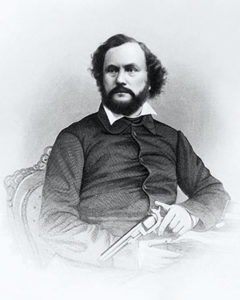
“Through providing efficient arms required during the 19th century, Colt revolutionized the arms industry and, though not alone in this role, he was unique and undeniably controversial,” the Old State House says in its announcement.
Registration for the talk isn’t required, but it is encouraged: http://bit.ly/2uuh70k.
Congress created the national historic park in 2014. The official opening is expected soon, but Barnett already gives walking tours of the component properties, including the factory complex, the city’s Colt Park (formerly part of the Colt estate), and the Church of the Good Shepherd, which Elizabeth Colt commissioned as a memorial to her husband, who was only 47 when he died in 1862.
You can keep up on Coltsville news in a variety of places, among them:
- the Coltsville page of Congressman John B. Larson’s website;
- the Friends of Coltsville page on Facebook; and
- the Hartford Preservation Alliance website.
Props for the Polish National Home
For a while, it looked as though the Polish National Home on Charter Oak Avenue had settled into hidden-gem status. Architecture buffs loved its circa-1930 Art Deco facade and beautiful ballroom; lovers of pierogies and beer always had a home in the unpretentious dining room. But even Hartford boosters would forget to list the Home as one of the city’s attractions.
Fortunately, that appears to be changing. The Hartford Courant has taken notice of a new generation of leaders at the Home. One of them, board president Rob Kwasnicki, told the newspaper that the Home aims to boost membership by not only remaining loyal to Polish heritage and culture but also becoming an engine of progress for the Charter Oak neighborhood and the city as a whole. Steps so far have included sprucing up the rooms new members are most likely to use, like the dining room, and loading up the calendar with community events.
“We have an opportunity for the Polish National Home to be be what it has always been: an anchor in the community,” Kwasnicki said. “We can be a focal point, a gathering place, a beacon or central point of informational disbursement.”
Still Missing the Whale
 Amazingly, it will be 20 years on Thursday since the Hartford Whalers played their last game. On April 13, 1997, they defeated the Tampa Bay Lightning at the Civic Center, 2-1, then decamped for Raleigh, North Carolina and changed their name to the Carolina Hurricanes.
Amazingly, it will be 20 years on Thursday since the Hartford Whalers played their last game. On April 13, 1997, they defeated the Tampa Bay Lightning at the Civic Center, 2-1, then decamped for Raleigh, North Carolina and changed their name to the Carolina Hurricanes.
It still hurts.
The Whale began life in 1971 as the Boston-based New England Whalers of the World Hockey League. The team moved to Hartford for the 1974-75 season, playing its first game in the brand-spanking-new Hartford Civic Center Coliseum on January 11, 1975. The team thrived in Hartford, which led to it becoming one of just four WHA teams accepted into the National Hockey League in the WHA-NHL merger of 1979. Along with the new league came a new name: the Hartford Whalers.
Software entrepreneur Peter Karmanos Jr. bought the Whalers in 1994 and soon began pressing the state of Connecticut, which owned the Civic Center, for a bigger and better facility, along with better lease terms. (Increased luxury-box seating and similar “revenue streams” figured prominently here.) Negotiations with the administration of Gov. John G. Rowland broke down. In March 1997, Karmanos announced that the current season would be his team’s last in Hartford.
Hartford Courant columnist Jeff Jacobs, who began covering the Whalers in 1984, wrote a tribute to the Whalers last Sunday, making sure to eviscerate both Karmonos and the recently re-imprisoned Rowland. One line in particular was news to me:
Rowland, from Waterbury and not a hockey guy, didn’t love the Whalers enough to do everything to save the team. General manager Jim Rutherford later told me if he had offered Karmanos anything resembling what he offered Robert Kraft to move the [New England] Patriots [to Connecticut], the NHL would still be in Hartford.
Argh!
So we are left with nostalgia. To that end, enjoy the great photo gallery that accompanies Jacobs’ column. It might also make you feel better to follow the indefatigable Hartford Whalers Booster Club on Facebook.
100 years after heading ‘Over There’*
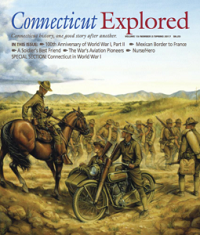 Tomorrow is the 100th anniversary of the United States’ entry into World War 1, and the history magazine Connecticut Explored marks it with a Spring 2017 issue full of articles on Connecticut’s role in the war effort. One of them, written by former Hartford Courant editor David Drury, tells the story of Ruth Hovey, a Hartford nurse who was honored by the French government for her service under fire on the Western Front.
Tomorrow is the 100th anniversary of the United States’ entry into World War 1, and the history magazine Connecticut Explored marks it with a Spring 2017 issue full of articles on Connecticut’s role in the war effort. One of them, written by former Hartford Courant editor David Drury, tells the story of Ruth Hovey, a Hartford nurse who was honored by the French government for her service under fire on the Western Front.
For even more on Connecticut’s involvement in the Great War, check out the Connecticut State Library’s repository of online material, “Connecticut in World War 1.” There’s also Mr. Drury’s excellent book, “Hartford in World War I.”
*”Over There” was a patriotic song that encouraged young men to join the military and fight in Europe. Listen to it here.
The next chapter of pro baseball in Hartford
With the Hartford Yard Goats finally set to begin their inaugural season, Hartford Magazine has marked the occasion by publishing a short history of professional baseball in the city, accompanied by some great photos.
Starting in 1874, when the Hartford Dark Blues played as one of the charter members of the National League, pro and semi-pro baseball has had a few sojourns here. The most notable teams were the Hartford Senators, a minor-league operation that lasted into the 1930s, and the Hartford Chiefs, who began began play in 1938 as a farm team of the Boston Braves. When the Braves left Boston for Milwaukee after the 1952 season, the Chiefs likewise left Hartford.
The Chiefs, Senators, and other teams played at Morgan G. Bulkeley Stadium, in the South End. Built in 1927, the 6,500-seat facility fell into disuse after the Chiefs left and was demolished in 1960. In 2013, local baseball lovers installed a plaque commemorating the stadium on the grounds of Ellis Manor, a rehabilitation and health care facility that now occupies the site.
For more on the stadium, here’s an article that stadium buff Norm Hausmann wrote for the Society for American Baseball Research (SABR).
In honor of St. Patrick’s Day
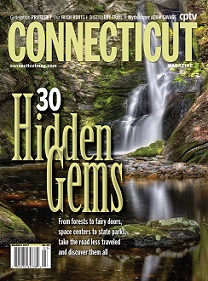 The latest issue of Connecticut Magazine features “Our Irish Soul: How the Irish Shaped Connecticut, and Vice Versa,” an article by Michael Lee-Murphy. Informative and well-written, it outlines the history of Irish immigrants in our state, starting from their arrival in the early 1600s as indentured servants. Hartford gets a few mentions, including the 1902 visit to the city by James Connolly, the revolutionary who went on to lead the Easter 1916 uprising in Dublin, which cost him his life. (Wounded and captured in the fighting, he was executed by the British while tied to a chair.) There’s also Catherine Flanagan, the Hartford-born daughter of Irish immigrants. A leader in the fight securing women’s right to vote, she spent 30 days in jail for a Washington, D.C. protest in 1917. In addition, according to Lee-Murphy, Flanagan campaigned across the U.S. for American recognition of the Irish Republic.
The latest issue of Connecticut Magazine features “Our Irish Soul: How the Irish Shaped Connecticut, and Vice Versa,” an article by Michael Lee-Murphy. Informative and well-written, it outlines the history of Irish immigrants in our state, starting from their arrival in the early 1600s as indentured servants. Hartford gets a few mentions, including the 1902 visit to the city by James Connolly, the revolutionary who went on to lead the Easter 1916 uprising in Dublin, which cost him his life. (Wounded and captured in the fighting, he was executed by the British while tied to a chair.) There’s also Catherine Flanagan, the Hartford-born daughter of Irish immigrants. A leader in the fight securing women’s right to vote, she spent 30 days in jail for a Washington, D.C. protest in 1917. In addition, according to Lee-Murphy, Flanagan campaigned across the U.S. for American recognition of the Irish Republic.
Another blog to bookmark
Anyone interested in the history of Hartford needs to make regular visits to “The Hartfordite,” the blog of longtime WFSB-TV3 news anchor Dennis House. The blog isn’t dedicated exclusively to city history–there’s also plenty about current events, especially when it’s covered on his Sunday morning program, “Face the State.” But House, a native New Englander who’s been with Channel 3 since 1992, clearly enjoys posting items concerning local history. And it’s a treat for readers when delves into his station’s video and photographic vaults, posting nuggets we otherwise wouldn’t see, like photographs of Hartford businesses in the 1970s and the newly opened Constitution Plaza in 1964.
Recently, House posted some great photos from the Ranger Andy Show, a children’s show that aired from 1957 to 1968, in hopes of jogging some memories; he’d like to talk to people who appeared on the station in its early days, as part of an upcoming 60th-anniversary celebration.


